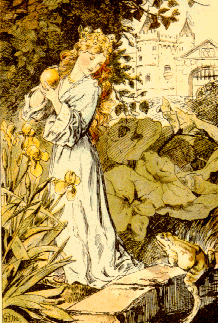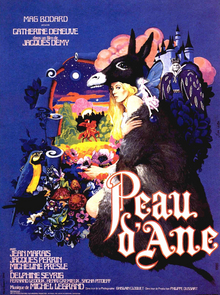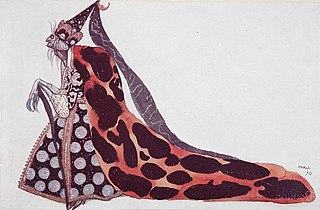
"Sleeping Beauty", also titled in English as The Sleeping Beauty in the Woods, is a fairy tale about a princess cursed by an evil fairy to sleep for a hundred years before being awakened by a handsome prince. A good fairy, knowing the princess would be frightened if alone when she wakes, uses her wand to put every living person and animal in the palace and forest asleep, to awaken when the princess does.

The Slipper and the Rose: The Story of Cinderella is a 1976 British musical retelling the classic fairy tale of Cinderella. The film was chosen as the Royal Command Performance motion picture selection for 1976.

In fairy tales, a fairy godmother is a fairy with magical powers who acts as a mentor or parent to someone, in the role that an actual godparent was expected to play in many societies. In Perrault's "Cinderella", he concludes the tale with the moral that no personal advantages will suffice without proper connections.

"The Frog Prince; or, Iron Henry" is a German fairy tale collected by the Brothers Grimm and published in 1812 in Grimm's Fairy Tales. Traditionally, it is the first story in their folktale collection. The tale is classified as Aarne-Thompson type 440.

Donkey Skin is a 1970 French musical fantasy comedy film directed by Jacques Demy, based on Donkeyskin, a 1695 fairy tale by Charles Perrault about a king who wishes to marry his own daughter. It stars Catherine Deneuve and Jean Marais, with music by Michel Legrand. Donkey Skin proved to be Demy's biggest success in France, with a total of 2,198,576 tickets sold.

Cendrillon (Cinderella) is an opera—described as a "fairy tale"—in four acts by Jules Massenet to a French libretto by Henri Caïn based on Perrault's 1698 version of the Cinderella fairy tale.

"The Blue Bird" is a French literary fairy tale by Madame d'Aulnoy, published in 1697. An English translation was included in The Green Fairy Book, 1892, collected by Andrew Lang.

"Katie Woodencloak" or "Kari Woodengown" is a Norwegian fairy tale collected by Peter Christen Asbjørnsen and Jørgen Moe in Norske Folkeeventyr. Andrew Lang included it in The Red Fairy Book.

"Donkeyskin" is a French literary fairytale written in verse by Charles Perrault. It was first published in 1695 in a small volume and republished in 1697 in Perrault's Histoires ou contes du temps passé. Andrew Lang included it, somewhat euphemized, in The Grey Fairy Book. It is classed among folktales of Aarne-Thompson type 510B, unnatural love.
The Princess Mayblossom is a French literary fairy tale written by Madame d'Aulnoy in 1697. Andrew Lang included it in The Red Fairy Book.
The White Doe or The Doe in the Woods is a French literary fairy tale written by Madame d'Aulnoy. Andrew Lang included it in The Orange Fairy Book.
The Child who came from an Egg or The Egg-Born Princess is an Estonian fairy tale, collected by Dr. Friedrich Reinhold Kreutzwald in Eestirahwa Ennemuistesed jutud.

Finette Cendron is a French literary fairy tale written by Madame d'Aulnoy.

The Wicked fairy is the antagonist of Sleeping Beauty. In some adaptations, she is known as Carabosse. The most notable adaptation of the character is Maleficent, a Disney villain who appeared in various Disney media, beginning with the 1959 Walt Disney film Sleeping Beauty.

Cinderella is a ballet-féerie in three acts, with the choreography of Enrico Cecchetti and Lev Ivanov supervised by Marius Petipa. Music is by Baron Boris Fitinhoff-Schell; the libretto is by Lidia Pashkova and Ivan Vsevolozhsky. It was first presented by the Imperial Ballet on 17 December [O.S. 5 December] 1893 at the Imperial Mariinsky Theatre in St. Petersburg, Russian Empire.
The Imp Prince is a French fairy tale written by Marie Catherine d'Aulnoy and published in her book Fairy Tales in 1697.
Bearskin is a French literary fairy tale by Marie-Madeleine de Lubert. It was included in her revised edition, published in 1753, of Henriette-Julie de Murat's last novel, Les Lutins du château de Kernosy, which is why it is often attributed to Madame Henriette-Julie de Murat.

"The Heart of Princess Joan" is a 19th-century fairy tale published in 1880 as part of the collection The Necklace of Princess Fiorimonde and other Stories. This was the second of three published collections of fairy tales by popular children's author, Mary De Morgan. Illustrations for the stories were provided by Walter Crane.












